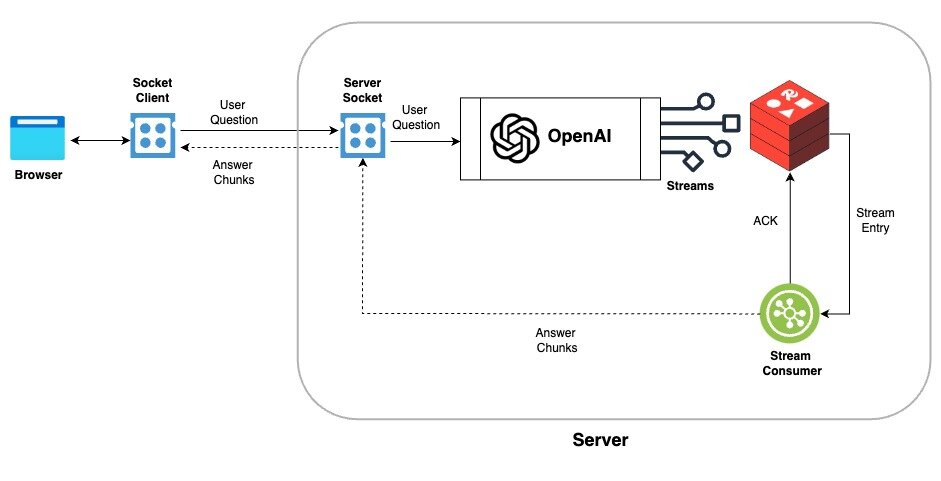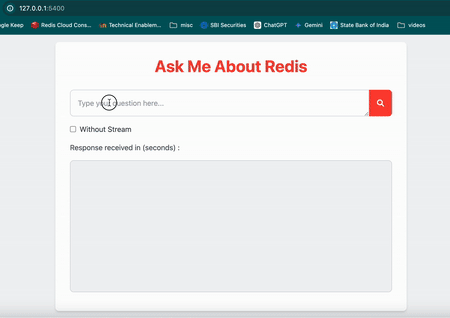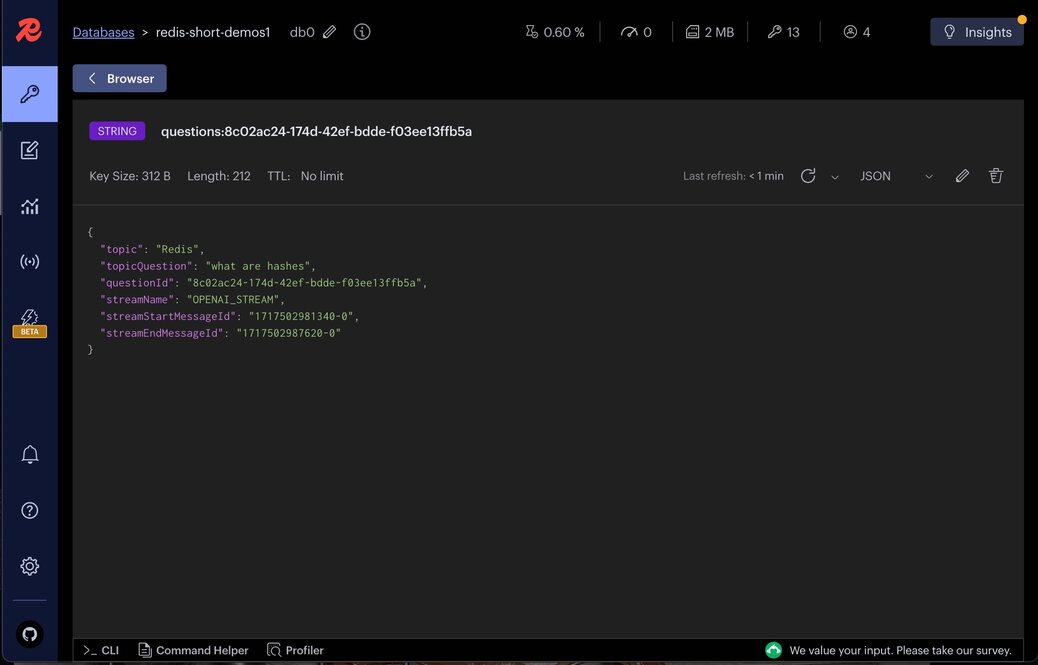

In this tutorial, we will explore how to stream output (in chunks) from a Large Language Model (LLM) to a browser using Redis Streams.
Redis Streams are powerful data structure that allows you to efficiently handle streams of data, similar to message queues or append-only logs.
You can store multiple fields and string values with an automatic ID generated for each stream entry.
The architecture flow of the application is as follows:

1. The browser sends a user question to the server using sockets.
2. The server receives the user question via sockets and forwards it to OpenAI (LLM) for processing.
3. OpenAI processes the user question and returns a response in chunks, which are then added to a Redis stream.
4. A stream consumer listens to the Redis stream and broadcasts the chunks to connected clients through sockets.
Download the source code of demo from the GitHub repository and navigate to the streaming-llm-output directory.
git clone https://github.com/redis-developer/redis-short-demos.git
cd redis-short-demos/streaming-llm-output
Install the dependencies
npm installCreate a .env file in the root of the project and add the following environment variables.
OPENAI_API_KEY=
OPENAI_ORGANIZATION=
REDIS_URL="redis://localhost:6379/"Start the application
# Start the backend node server
npm run backend
# Start the frontend app
npm run frontendOpen http://127.0.0.1:5400/ in your browser to play with demo

Once you have the application running, you can ask a question in the input box and click on the search button. The application will stream the output from the LLM in real-time instead of waiting for the entire output to be generated.
Now, Select `Without Stream` checkbox and click on search button to see the output without streaming. In this case, you will notice a delay in displaying the output as it waits for the entire output to be generated.
Let's dive into the code snippets to understand how we can stream LLM output to the browser using Redis Streams.
This module provides utility functions to interact with Redis Streams.
import { commandOptions, createClient } from 'redis';
import { LoggerCls } from './logger.js';
// Function to add an item to a Redis Stream
async function addItemToStream(streamKey: string, item: any) {
let insertedId = '';
try {
const client = getConnection();
if (streamKey && item && client) {
const id = '*'; // Auto-generate ID
insertedId = await client.xAdd(streamKey, id, item);
}
} catch (err) {
LoggerCls.error('addItemToStream', err);
}
return insertedId;
}
// Function to get the last ID of a Redis Stream
async function getLastIdOfStream(streamKey: string) {
let lastId = '0-0';
try {
if (streamKey) {
/*
xRevRange(): Read stream in reverse order
startId: + represents latest item
endId: - represents oldest item
COUNT: 1 to get only 1 item
*/
const result = await nodeRedisClient?.xRevRange(streamKey, '+', '-', {
COUNT: 1,
});
if (result && result.length > 0) {
lastId = result[0].id;
}
}
} catch (err) {
console.log(err);
}
return lastId;
}
// Function to read from a Redis Stream
async function readStream(
stream: string, // stream key
lastId: string, // id to start reading from
startChunk: string, // listen message to start sending data to callback
endChunk: string, // listen message to stop reading
clientId: string, // socket id
activeListeners: Map<string, boolean>, // to keep track of active socket listeners
callback: (data: any, id?: string) => void,
) {
let reading = false;
const isActiveClient = activeListeners.get(clientId);
// loop for active clients only
while (isActiveClient) {
try {
const results = await nodeRedisClient?.xRead(
commandOptions({
isolated: true,
}),
{ key: stream, id: lastId },
{ BLOCK: 0, COUNT: 1 }, // BLOCK 0 (ms) means don't timeout till new data is available
);
if (results) {
for (const result of results) {
for (const item of result.messages) {
if (item?.message?.chunkOutput.startsWith(startChunk)) {
// start reading only if startChunk is found
reading = true;
}
if (reading) {
lastId = item.id;
//send stream data to callback
callback(item.message, lastId);
if (item?.message?.chunkOutput.endsWith(endChunk)) {
console.log('End of chunk found');
return; // exit loop if endChunk is found
}
}
}
}
}
} catch (err) {
LoggerCls.error('readStream', err);
}
}
}
// Function to set a JSON item in Redis
async function setJsonItem(_key: string, _value: any) {
const result = await nodeRedisClient?.set(_key, JSON.stringify(_value));
return result;
}
This module handles creating prompts and streaming responses from the LLM.
import { ChatOpenAI } from '@langchain/openai';
import {
ChatPromptTemplate,
SystemMessagePromptTemplate,
} from '@langchain/core/prompts';
import { HumanMessage, SystemMessage } from '@langchain/core/messages';
import { StringOutputParser } from '@langchain/core/output_parsers';
import * as redisUtils from './utils/redis-wrapper.js';
import { LoggerCls } from './utils/logger.js';
// Function to get LLM chain for a user question
const getQuestionChain = async function (
_model: ChatOpenAI,
_questionId: string,
_topic: string,
_topicQuestion: string,
) {
const outputParser = new StringOutputParser();
// Create a prompt
let systemMsg = SystemMessagePromptTemplate.fromTemplate(
`You are an expert in answering questions about {topic}.
All questions are about particular topic "{topic}".
Make sure your answer is related to {topic}. `,
);
let humanMsg = new HumanMessage(_topicQuestion);
const prompt = ChatPromptTemplate.fromMessages([systemMsg, humanMsg]);
LoggerCls.info('Prompt: \n', await prompt.format({ topic: _topic }));
// Create a pipeline chain
const chain = prompt.pipe(_model).pipe(outputParser);
return chain;
};
// Function to ask a question to LLM and stream the output
const askQuestion = async function (
_model: ChatOpenAI,
_questionId: string,
_topic: string,
_topicQuestion: string,
_streamName: string,
) {
if (_model && _topic && _topicQuestion) {
const startChunkLbl = `START:${_questionId};<br/>`;
const endChunkLbl = `<br/>;END:${_questionId}`;
const chain = await getQuestionChain(
_model,
_questionId,
_topic,
_topicQuestion,
);
// Stream the output
let streamHandle = await chain.stream({
topic: _topic,
});
// add start chunk to stream
const questionStartMessageId = await redisUtils.addItemToStream(
_streamName,
{
questionId: _questionId,
chunkOutput: startChunkLbl,
},
);
// add LLM output chunks to stream
for await (const chunk of streamHandle) {
//LoggerCls.debug(chunk);
await redisUtils.addItemToStream(_streamName, {
questionId: _questionId,
chunkOutput: chunk.toString(),
});
}
// add end chunk to stream
const questionEndMessageId = await redisUtils.addItemToStream(_streamName, {
questionId: _questionId,
chunkOutput: endChunkLbl,
});
// add question details/ meta data to redis (for future re-read of stream)
const questionDetails = {
topic: _topic,
topicQuestion: _topicQuestion,
questionId: _questionId,
streamName: _streamName,
streamStartMessageId: questionStartMessageId,
streamEndMessageId: questionEndMessageId,
};
await redisUtils.setJsonItem(`questions:${_questionId}`, questionDetails);
}
};
This module sets up a Socket.IO server events to handle real-time communication between the client and server.
import { v4 as uuidv4 } from 'uuid';
import { Server } from 'socket.io';
import { ChatOpenAI } from '@langchain/openai';
import * as redisUtils from './utils/redis-wrapper.js';
import { LoggerCls } from './utils/logger.js';
import { askQuestion } from './question.js';
import { CONFIG } from './config.js';
// setup socket to read stream
const initSocketXRead = async (socketServer: Server, model: ChatOpenAI) => {
const activeListeners = new Map<string, boolean>();
// listen for new socket connections
socketServer.on('connection', (socket) => {
LoggerCls.info('a user connected');
activeListeners.set(socket.id, true);
// listen for askQuestion event
socket.on('askQuestion', async ({ topic, topicQuestion }) => {
const questionId = uuidv4();
//lastId to prevent re scan of older data
const lastId = await redisUtils.getLastIdOfStream(CONFIG.OPENAI_STREAM);
// trigger `askQuestion` asynchronously, It sends question to OpenAI API and stores the response in the Redis stream as chunks
askQuestion(
model,
questionId,
topic,
topicQuestion,
CONFIG.OPENAI_STREAM,
);
// Read messages from Redis stream between startChunk and endChunk
const startChunk = `START:${questionId};`;
const endChunk = `;END:${questionId}`;
redisUtils.readStream(
CONFIG.OPENAI_STREAM,
lastId,
startChunk,
endChunk,
socket.id,
activeListeners,
(data) => {
LoggerCls.info(data.chunkOutput);
// Emit the chunk to the client (browser)
socket.emit('chunk', data.chunkOutput);
},
);
});
socket.on('disconnect', () => {
LoggerCls.info('user disconnected');
activeListeners.set(socket.id, false);
});
});
};
This module sets up an Express server and integrates the Socket.IO server.
import express from 'express';
import cors from 'cors';
import { createServer } from 'http';
import { Server } from 'socket.io';
import { ChatOpenAI } from '@langchain/openai';
import { v4 as uuidv4 } from 'uuid';
import { config } from 'dotenv';
import * as redisUtils from './utils/redis-wrapper.js';
import { LoggerCls } from './utils/logger.js';
import { initSocket } from './socket.js';
config();
const model = new ChatOpenAI({
modelName: 'gpt-4',
apiKey: process.env.OPENAI_API_KEY,
});
//---- express server
const app = express();
const httpServer = createServer(app);
const socketServer = new Server(httpServer, {
cors: {
origin: '*',
methods: ['GET', 'POST'],
},
});
app.use(cors());
app.use(express.json());
httpServer.listen(3000, async () => {
const REDIS_URL = process.env.REDIS_URL || '';
await redisUtils.setConnection(REDIS_URL);
// set up socket server events
initSocketXRead(socketServer, model);
LoggerCls.info('Backend listening on *:3000');
});
//---- express server
Now, back end server listens for the `askQuestion` socket event from the client (browser) and triggers the `askQuestion` function to send the question to the LLM and stream the output to the Redis stream.
The `readStream` function reads the stream data and emits the chunks to the client (browser) using the `chunk` event.
In this tutorial, we are using `xRead` command to read the stream data, but you can also use `xReadGroup` command to read the stream data in consumer groups and handle the consumer acknowledgment and re-reading of the stream data in case of failure. Sample code for `xReadGroup` is available in the `streaming-llm-output/src/socket-x-read-group.ts` file in demo source code.
This module sets up a simple front end to send the question to the server and display the output in real-time.
const socket = io('http://localhost:3000');
const topic = 'Redis';
// Function to send the question to the server
function onSearch() {
const outputDiv = document.getElementById('output');
const question = document.getElementById('question').value; // user input
// Clear previous output
outputDiv.innerHTML = '';
// Use socket to emit the question
socket.emit('askQuestion', {
topic: topic,
topicQuestion: question,
});
}
function onPageLoad() {
// Listen for streamed chunks of the LLM’s response
socket.on('chunk', (chunk) => {
const outputDiv = document.getElementById('output');
outputDiv.innerHTML += chunk;
});
}Redis Insight is a powerful GUI tool that allows you to interact with Redis data visually. Let's monitor the Redis stream `OPENAI_STREAM` created by the application using Redis Insight.

Let's visualize the `question` JSON stored in Redis

By leveraging Redis Streams, we can efficiently stream the output from an LLM in real-time. This tutorial demonstrated how to set up the necessary backend and frontend components to achieve this. Redis Streams provide a robust solution for handling real-time data, ensuring that our application can scale and handle large volumes of data efficiently.